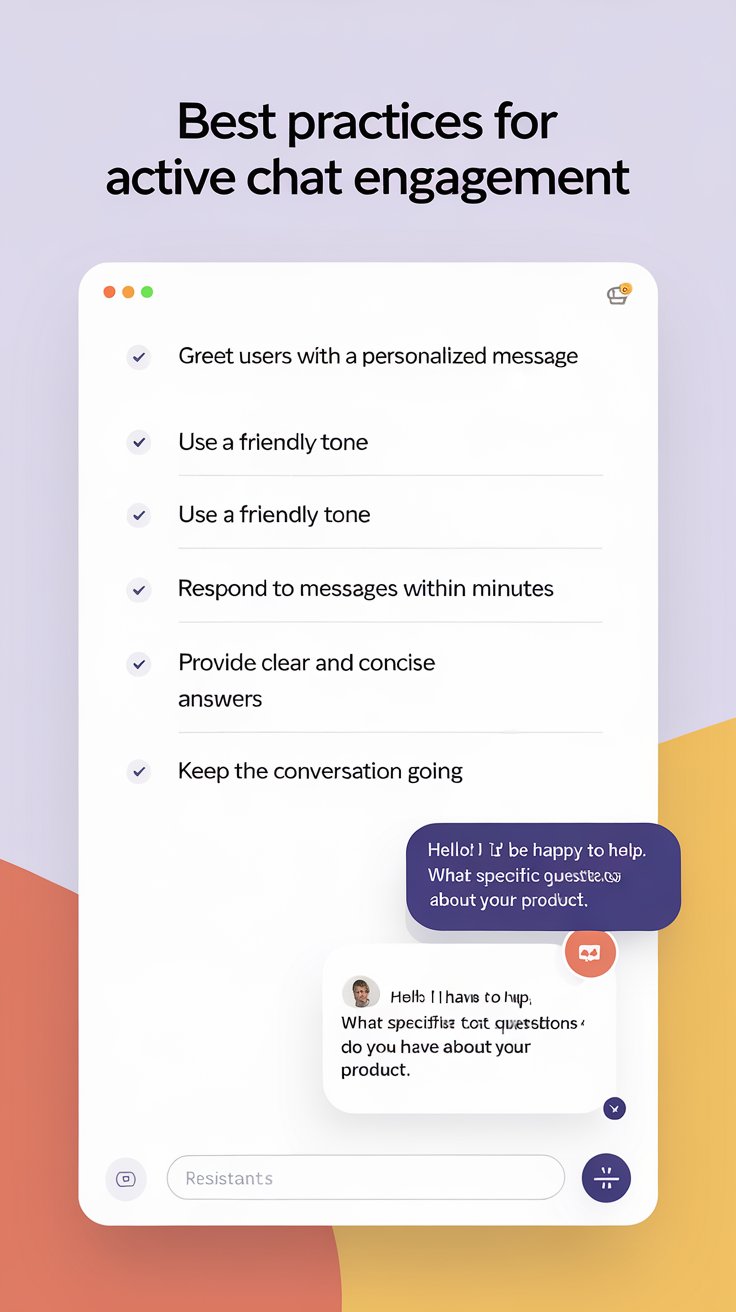Introduction
In the modern digital marketplace, engaging website visitors is more crucial than ever for businesses looking to maximize their online presence. One effective strategy to achieve this is through the implementation of active chat features on websites. Active chat not only enhances user experience but also fosters deeper connections between brands and customers. By leveraging real-time communication tools, businesses can provide immediate support, answer queries, and ultimately drive conversions.
As consumer behavior evolves, the importance of active chat strategies continues to grow. Visitors increasingly expect prompt responses and personalized interactions when browsing online. In this article, we will explore various active chat techniques and strategies that can significantly boost engagement rates, improve customer satisfaction, and lead to increased loyalty. We will delve into best practices, technology tools, and case studies illustrating the effectiveness of active chat in creating a more dynamic online customer experience.
Understanding Active Chat in the Digital Age
Active Chat: An Essential Engagement Tool
Active chat represents a dynamic shift in customer interaction strategies, enabling real-time communication between businesses and website visitors. Unlike passive forms of communication, such as email or traditional customer service forms, active chat fosters immediate engagement, allowing users to receive instant responses to their inquiries. This immediacy is vital in today’s fast-paced digital environment, where users expect not only quick answers but also personalized interactions that make them feel valued.
The significance of active chat in contemporary online customer engagement cannot be overstated. It creates a dialogic space where businesses can address specific customer needs, collect valuable feedback, and enhance user experiences. In a landscape characterized by a plethora of options, active chat can set organizations apart, providing a competitive edge by enhancing customer satisfaction through timely support. The distinction from passive communication methods lies in its proactive nature; businesses can approach users directly and encourage them to discuss their queries or concerns. This two-way interaction builds relationships based on trust and responsiveness.
Active chat platforms let businesses keep an eye on what customers are doing in real-time. This helps them get a better grip on what users like and what issues they’re running into. With this info, they can improve their marketing plans, design specific campaigns, and make the customer experience feel more personal. Plus, these chat tools usually have handy features like quick replies, chatbots, and links to customer management systems, which makes communication way smoother.
Given the advancements in technology, including artificial intelligence and machine learning, active chat is evolving to become even more effective. Smart algorithms can predict user needs based on past interactions and provide bespoke support, thereby enhancing the overall user experience. In an age where customer retention is paramount, the ability to engage actively with visitors not only boosts immediate attraction but also fosters long-term loyalty to the brand.
Active chat is a game changer for how people and businesses connect online. It creates a lively space where users can chat and engage, making communication smoother and helping to build strong relationships with customers. Because it boosts engagement and happiness, active chat is a must-have in today’s digital world.
The Benefits of Implementing Active Chat
Enhancing Customer Satisfaction
Active chat has become a powerful tool for businesses aiming to improve customer satisfaction. One of the primary benefits is the immediacy it offers; customers today expect quick answers to their queries. By implementing active chat, companies can provide real-time assistance, ensuring that visitors do not face delays when seeking information. This instant connectivity not only resolves issues promptly but also demonstrates that a business values its customers’ time, leading to a more positive interaction experience.
Active chat really helps with personal connection. Customers get to chat with reps who know how to help with their unique needs. This kind of friendly communication builds trust and makes people feel connected which is super important for keeping customers coming back. By genuinely listening and answering questions, businesses can make the experience way better and more enjoyable for everyone.
Boosting Conversion Rates
Another significant benefit of active chat is its capacity to enhance conversion rates. When potential customers visit a website, they are often in a decision-making phase, weighing their options. Active chat acts as a strategic touchpoint, providing answers and clarity that may ultimately guide them toward making a purchase. For instance, when customers engage in a chat session, they are likely to have questions about product details, pricing, or shipping options. Addressing these concerns in real-time can significantly influence their purchasing decisions.
Hey, businesses can take charge with some smart chat tactics. They can start chatting with customers based on what they’re doing, like if they’ve been hanging out on a product page for a while or if they’ve left things in their cart. By contacting visitors when they seem unsure, companies can give them a little nudge to finish their purchase, which can boost those conversion rates.
Fostering Brand Loyalty
Active chat not only serves immediate customer needs but also plays a vital role in building long-term brand loyalty. When customers feel heard and supported, they are more likely to return to the same brand for future purchases. Furthermore, consistent engagement through active chat can help businesses create a profound understanding of customer preferences and behaviors.
By analyzing chat interactions, companies can gather valuable insights that drive improvements in products and services, showcasing a commitment to customer satisfaction. This responsiveness not only reinforces positive experiences but also cultivates a loyal customer base, ensuring sustained business growth. In a world where the competition for customer loyalty is fierce, active chat emerges as a vital strategy in retaining and nurturing customer relationships.
Best Practices for Active Chat Engagement
Effective Active Chat Strategies
To maximize customer engagement through active chat, it is essential to adopt effective strategies that resonate with visitors. One of the fundamental best practices is to establish a friendly and approachable tone. Staying conversational while maintaining professionalism ensures that visitors feel comfortable expressing their needs. The language used should reflect the brand’s personality, fostering a connection rather than appearing robotic. This approach enhances the overall satisfaction of interactions.
Response times play a critical role in active chat effectiveness. Swift replies are vital, as customers may lose interest if they encounter delays. Setting specific benchmarks for response times, such as under a minute for initial replies and no longer than two minutes for follow-up messages, can significantly improve the customer experience. This quick turnaround reflects a brand’s commitment to service and encourages visitors to return.
Personalization is another key component of successful active chat strategies. Tailoring conversations based on visitor data creates a more customized interaction. For example, using the visitor’s name or referencing their previous interactions with the website can make them feel valued. Utilizing chatbots that incorporate customer data allows for real-time personalization, enhancing the feeling of being cared for. This approach not only engages visitors but also strengthens brand loyalty.
Another essential practice involves proactive engagement. Instead of waiting for visitors to initiate chat, businesses can employ strategies such as timed pop-ups that offer assistance based on browsing behavior. For instance, if a visitor spends an extended period on a particular product page, a friendly prompt offering help or additional information can lead to higher conversion rates.
It’s super important to keep checking and tweaking your chat strategies for ongoing success. Getting feedback from customers who have chatted with you can really help you see where things could get better. By looking at chat transcripts, businesses can adjust their methods to make sure they’re still working well and meeting what visitors expect.
By integrating these best practices—developing a friendly tone, ensuring rapid response times, personalizing interactions, engaging visitors proactively, and continually refining strategies—businesses can create an enriching chat experience that deepens customer engagement and fosters long-term relationships.
Technological Tools for Active Chat Success Enhancing Engagement Through Platforms
When it comes to active chat, having the right tech tools can really boost how you connect with customers and keep them coming back. There are lots of platforms out there and each one has its own cool features to help you chat with visitors on your website in real-time. Picking the right tool is super important for businesses that want to make the most of their active chat strategies.
Features and Advantages of Active Chat Platforms
Modern active chat platforms come loaded with features that meet diverse business requirements. Here is a review of several prominent tools in the market:
- LiveChat: This platform offers robust functionalities such as customizable chat widgets, file sharing, and chat transcript history. The integration with numerous CRM and e-commerce platforms streamlines customer interactions, making it easier to understand customer needs and improve service delivery.
- Zendesk Chat: Known for its versatility, Zendesk Chat allows for seamless engagement across various channels, including web and mobile. Its proactive chat requests and automated responses can provide users with immediate assistance, effectively reducing response time and enhancing visitor satisfaction.
- Intercom: Aimed at fostering personalized user experiences, Intercom offers features like automated messages based on user behavior and segmentation. This needs-based approach makes it simpler to anticipate visitor inquiries, thereby maintaining engagement and increasing conversion rates.
- Tawk.to: This free-to-use platform provides an excellent option for businesses looking to minimize operational costs while enhancing customer interaction. Its real-time notifications, along with mobile app accessibility, ensure that businesses can engage customers effectively, regardless of their location.
- Drift: Focused on marketing automation, Drift uses conversational marketing to engage users when they are most receptive. Its AI features enable chatbots to qualify leads and connect them with human agents, providing an insightful blend of efficiency and personal engagement.
Choosing the best active chat tool hinges on understanding the specific goals of the business and the preferences of its target audience. Factors like ease of integration with existing systems, the ability to gather data for analytics, and customer support capabilities play a pivotal role in the selection process. Each technological tool aims to facilitate more effective communication, paving the way for better customer experiences and ultimately leading to higher retention rates.
The journey into utilizing these technological advancements leads businesses to realize the importance of being attuned to visitor needs, effectively bridging the gap between query resolution and customer satisfaction.
RealWorld Case Studies Active Chat Strategies for Enhanced Customer Engagement
Successful Implementations Across Various Industries
Implementing active chat strategies has proven effective for numerous businesses, leading to increased customer engagement and retention. One notable example is Zappos, a giant in the online retail space, known for its outstanding customer service. By integrating live chat on its website, Zappos allows customers to receive immediate assistance, enabling them to make informed purchasing decisions. The company reported that the live chat feature not only reduced the number of abandoned carts but also enhanced customer satisfaction. The key takeaway from Zappos is that personalized assistance via chat can create a more inviting shopping environment.
Another compelling case can be found in the travel industry with Booking.com. They utilize chatbots to assist users in navigating their services. By employing an AI-driven chat system, the platform effectively handles common queries related to reservations and travel plans. Booking.com saw a significant rise in user interactions and conversion rates attributed to their active chat feature, underscoring the effectiveness of streamlining processes through instant communication. The emphasis here is on being proactive; having a chat feature that preemptively addresses user needs can dramatically enhance the overall user experience.
In the technology sector, HubSpot stands out with its use of active chat strategies to engage potential leads. The company employs a combination of chatbots and live agents to handle complex inquiries. Their approach allows potential customers to receive immediate responses while simultaneously gathering valuable information that can aid in nurturing leads. HubSpot has reported increases in both lead conversion rates and customer engagement, demonstrating that a hybrid chat strategy can adapt to the varying needs of customers. This case illustrates the importance of employing both automated and human elements to cater to diverse user queries.
Learning from the Experiences of Others
These case studies reveal that successful active chat strategies share common traits: responsiveness, personalization, and adaptability. Businesses should focus on these elements to foster meaningful interactions and build lasting relationships with their customers. By analyzing these successful implementations, organizations can draw insights and adapt similar strategies to fit their unique contexts. Ultimately, the evidence suggests that when businesses prioritize engagement through active chat, they not only enhance customer satisfaction but also drive retention, making it a vital component of their overall strategy.
Overcoming Challenges in Active Chat Strategies for Effective Implementation
Identifying Common Challenges in Active Chat Implementation
Implementing active chat as a core component of customer engagement strategies can be highly beneficial. However, businesses often face specific challenges that hinder their success. One common issue is the lack of a proper strategy for integrating chat solutions into existing workflows. Without a clear plan, businesses may struggle to maintain consistent communication with visitors, leading to missed opportunities for engagement.
Another challenge is staffing adequately to manage chat interactions effectively. Many companies underestimate the volume of inquiries they will receive, resulting in long wait times and frustrated visitors. This can dramatically diminish the positive impacts that active chat is meant to have on user experience.
Content quality also plays a significant role in effective active chat implementation. Inadequate responses, vague information, or unpersonalized interactions can turn potential customers away rather than draw them in. The difficulty of maintaining an engaging conversation while ensuring accuracy and relevance can pose a substantial hurdle.
Solutions to Overcome Active Chat Challenges
Overcoming these challenges demands strategic foresight and investment in resources. To address workflow integration, businesses should develop a comprehensive plan that outlines the objectives of the chat feature, defines key performance indicators (KPIs), and integrates chat with other customer relationship management (CRM) tools. Regular training for staff on the latest chat functions and engagement techniques can improve communication quality and enhance visitor experience.
For staffing, companies can adopt a flexible approach by utilizing chatbots to handle low-complexity inquiries. This allows human agents to focus on more intricate questions, ensuring that customer concerns are addressed promptly. Furthermore, businesses should monitor chat volume and adjust staffing levels accordingly, enabling them to respond effectively during peak times.
Improving content quality can be achieved by leveraging customer feedback and data analytics. Regularly reviewing chat transcripts can highlight common inquiries and concerns, allowing businesses to refine their chat scripts accordingly. Additionally, employing personalization techniques, such as welcoming returning customers by name or recommending products based on past interactions, can significantly enhance user satisfaction and engagement.
By proactively addressing these challenges, businesses can harness the full potential of active chat, leading to improved customer relationships and enhanced retention over time.
Future Trends in Active Chat Technology Shaping Customer Engagement
Emerging Innovations in Active Chat
The landscape of active chat technology is undergoing a significant transformation, fueled by advancements in artificial intelligence and machine learning. These developments are changing how businesses engage with customers and enhance user experience. As organizations strive to provide more personalized and efficient interactions, several emerging innovations are shaping the future of active chat solutions.
One of the most promising trends is the integration of natural language processing (NLP) capabilities. By leveraging NLP, active chat systems can understand and respond to customer inquiries in a more human-like manner, enabling a smoother flow of conversation. This technology allows for more nuanced communication, understanding context, and sentiment, which ultimately enhances the overall user experience.
More and more businesses are using chatbots that are designed for specific fields. For example, retail chatbots can suggest products based on what you’ve looked at before and what you like. On the other hand, service bots can help you solve ticket issues right away. These specialized bots not only make conversations with customers feel more personal but also help keep them around by showing that they care and pay attention to what people need.
Personalization and Proactive Engagement
As competition intensifies, personalized customer engagement is becoming paramount. Active chat technologies are leaning towards delivering customized experiences through data-driven insights. By analyzing user data, businesses can deploy proactive chat strategies, initiating conversations based on user behavior or even triggering chats during critical moments, like cart abandonment. This forward-thinking approach can effectively capture interest and prevent potential loss of sales.
You know what’s really catching on nowadays? Video chat in how businesses communicate. It brings a personal touch to the service which makes things feel more real and helps tackle problems faster. This is especially true for places like healthcare and real estate, where seeing something can really clear things up. Video chat is turning into a must-have for keeping customers engaged.
As active chat technology continues to evolve, its role in shaping customer communications will grow. Businesses that stay ahead of these trends will not only enhance their customer engagement strategies but also build lasting relationships that drive retention and loyalty.
Conclusion and Action Steps Maximizing Engagement Through Active Chat Strategies
To effectively implement active chat strategies and keep website visitors engaged, it is essential to synthesize the key concepts presented throughout this article. Active chat serves as a dynamic interface, allowing businesses to facilitate real-time communication with customers. Engaging visitors in meaningful dialogue not only enhances their experience but also fosters loyalty and retention.
Essential Elements of Active Chat Implementation
For businesses looking to leverage active chat effectively, a structured approach is vital. Here are several actionable steps to consider:
- Define Objectives: Clarify the primary goals of integrating active chat. Is it to provide immediate customer support, boost sales, or gather feedback? Understanding the objectives will guide the chat’s functionalities.
- Choose the Right Tools: Invest in a robust chat platform that offers features such as AI-driven responses, seamless integration with existing systems, and analytics for performance monitoring. The right tools enhance both user experience and operational efficiency.
- Train Your Team: Equip your team with essential training on active chat best practices. Ensure they are knowledgeable about the products or services offered and can communicate effectively and empathetically with customers.
- Create Proactive Engagement Strategies: Develop scripts for common inquiries and set up proactive chat invitations based on user behavior, such as time spent on a page or the number of visits. This can encourage users to engage before they even ask for help.
- Monitor and Measure Effectiveness: Regularly analyze chat performance metrics, such as response times, customer satisfaction ratings, and conversion rates. This data is invaluable for adjusting strategies and improving engagement.
Fostering a Customer-Centric Culture
Active chat should not merely be seen as a transactional tool; it must be woven into the fabric of a customer-centric culture. Prioritize understanding customer motivations and challenges while delivering value through each interaction. Encouraging feedback from users will further refine the chat experience, resulting in increased satisfaction and loyalty over time.
By strategically implementing active chat practices, businesses not only enhance engagement but also nurture lasting relationships with their audience. Through a commitment to continuous improvement and adaptability, companies can position themselves at the forefront of customer communication and experience, ensuring a sustainable competitive edge in their market.
Conclusions
Using active chat strategies can really boost how engaged visitors feel on your website. When you offer real-time communication, you can quickly tackle any questions or concerns customers might have, which helps build that all-important connection and trust. This article shares some handy tips that give businesses what they need to improve their online chats, leading to happier customers who stick around longer.
As we look forward, it is clear that the use of active chat will continue to evolve with technological advancements. Companies that embrace these strategies will not only stand out in the competitive digital landscape but also ensure long-term success by creating lasting relationships with their customers, paving the way for future engagement and retention.





















